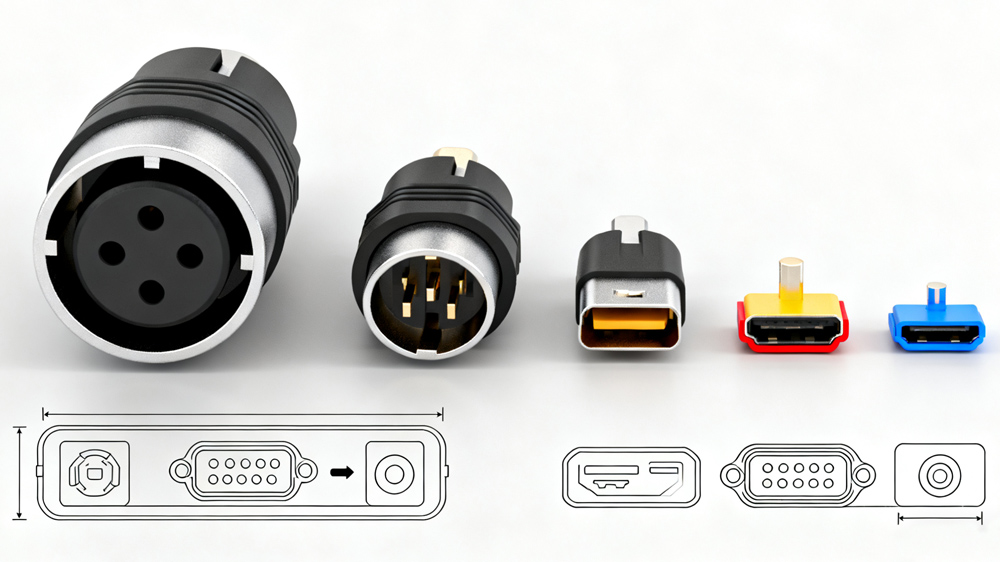Selecting the right AC and DC power connectors for your electronic devices is an important choice that influences performance, safety, and longevity.
Power connectors serve as the bridge between your devices and their energy sources, and using the wrong type can lead to poor connections, electrical hazards, or device malfunction. This guide breaks down the essential factors to consider when selecting the right AC and DC power connectors.

What is an AC Adapter?
An AC adapter, also referred to as a power supply or wall wart, converts alternating current (AC) from a wall outlet into a voltage suitable for your device. AC adapters are widely used for consumer electronics, including laptops, routers, and home appliances. Choosing the right AC adapter ensures your device receives a stable voltage and current, which can prevent damage and improve overall efficiency.
AC Connector Sizes
AC connectors come in various sizes, and selecting the correct one is crucial. Standard connector sizes include barrel connectors, C13/C14 types for desktop PCs, and two- or three-prong designs for household electronics. When choosing a connector, consider the current and voltage requirements of your device, as well as the physical dimensions of the plug and receptacle. Using a connector that is too small or too large can cause poor contact, overheating, or even short circuits.
Mounts for AC Power Connectors
Mounting options for AC power connectors can vary based on the application. Common mounts include panel mounts, chassis mounts, and PCB-mounted connectors. Panel-mounted connectors are often used in devices with accessible external panels, while chassis-mounted options are more secure and used in industrial applications. PCB-mounted connectors are ideal for compact electronics that require direct connection to the circuit board. Choosing the right mount ensures a secure and stable connection.
AC Connector Useful Features
Modern AC connectors often include features that enhance safety and convenience. Features such as built-in fuses, strain relief, locking mechanisms, and polarity indicators help prevent damage and ensure proper installation. Additionally, connectors with color-coded or keyed designs can reduce the risk of connecting the wrong voltage or current type.
What is a DC Adapter?
A DC adapter provides direct current (DC) to your electronic devices, often converting AC power from the wall into the necessary DC voltage. DC adapters are common in devices like LED lighting, small electronics, and battery charging systems. Selecting the correct DC adapter is essential for device performance and longevity, as mismatched voltage or current can lead to overheating or permanent damage.
DC Connector Sizes
DC connectors come in a variety of sizes to accommodate different voltage and current levels. Standard sizes include barrel connectors (commonly 2.1mm and 2.5mm inner diameters) and coaxial power plugs. When choosing a DC connector, pay attention to both the inner and outer diameters, as well as the current rating. Using the wrong size can result in loose connections, arcing, or insufficient power delivery.
DC Connector Mounts
DC connectors also offer various mounting options, including panel mounts, chassis mounts, and PCB-mounted options. Panel-mounted connectors allow easy access and replacement, while chassis-mounted connectors provide a secure and durable connection. PCB-mounted connectors are suitable for compact designs and offer direct integration into electronic circuits. Selecting the appropriate mount type depends on your device’s design and intended usage.
DC Connector Useful Features
DC connectors can include features that simplify installation and enhance safety. Common features include polarity protection, locking mechanisms, strain relief, and weatherproofing for outdoor applications. These features help ensure a secure, reliable connection while reducing the risk of damage or user error.
Check Electrical Ratings to Choose the Right AC Adapter for Your Device
Always check the electrical ratings of both the device and the AC adapter. Voltage, current, and polarity must match to ensure safe and efficient operation. Overvoltage or undervoltage can cause device failure, while excessive current may lead to overheating or fire hazards. Matching the electrical ratings helps ensure your device performs as expected and extends its lifespan.
Select an AC Adapter and Device with Matching Specs
In addition to voltage and current, consider additional specifications such as ripple tolerance, efficiency, and thermal management. Some devices may require regulated DC output or minimal noise for sensitive electronics. By carefully matching the AC adapter to your device’s specifications, you can optimize performance and reliability.
Mounting Options
Consider the physical installation and environmental conditions when selecting connector mounts. For example, panel-mounted connectors are ideal for devices that require frequent connection and disconnection, while chassis-mounted options are better suited for permanent installations. Proper mounting not only ensures a stable electrical connection but also protects against wear and mechanical stress.
Conclusion
Selecting the right AC and DC power connectors involves more than simply matching plug shapes. Consider connector sizes, mounts, useful features, and electrical ratings to ensure safe and reliable operation.
By taking the time to choose the appropriate connectors for your devices, you can prevent potential hazards, improve performance, and extend the life of your electronics. Choosing the right AC and DC power connectors is a small but crucial step in building a dependable and efficient electronic setup.
 +86 138-6870-3133
+86 138-6870-3133 sales@lanzmfg.com
sales@lanzmfg.com EN
EN CN
CN Search
Search